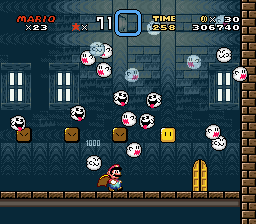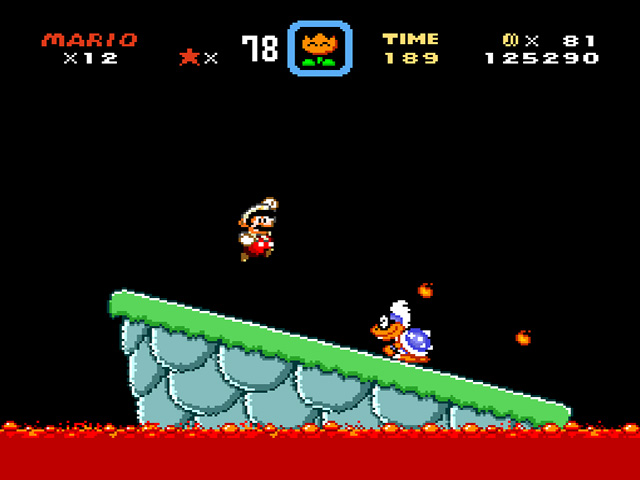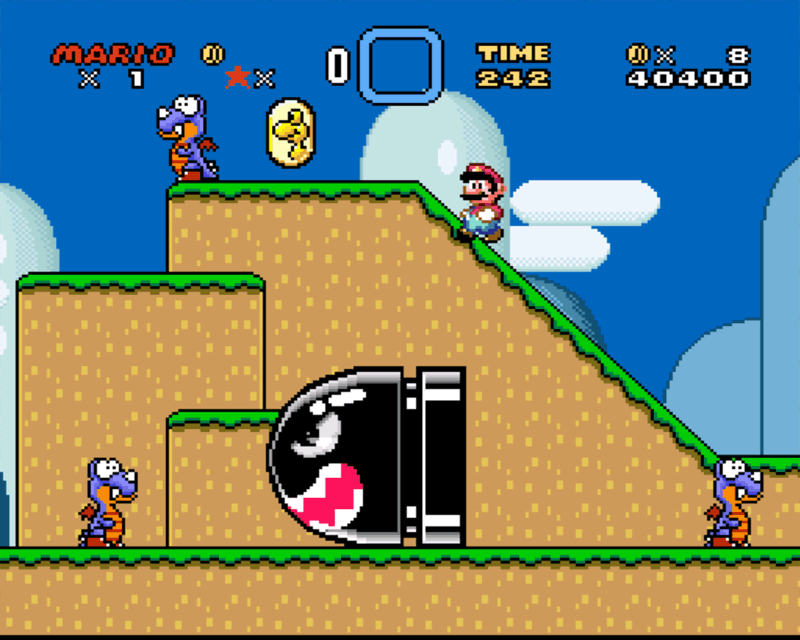What a Wonderful World
In 1991, Nintendo released Super Mario World, bundled with their brand new home console, the Super Nintendo. It was heralded as a classic and further cemented Mario as the go-to franchise for Nintendo systems. The game brought the world of Mario into 16-bit, accompanied by polished gameplay, visuals, and sound design. It was amazing for its generation. Decades later, Super Mario World is still the one game that I revisit at least once a year, and that is because it has withstood the test of time.

Gameplay
Super Mario World is a platformer like the NES Mario titles that came before it. It excels in its genre through its exemplary level design, masterful controls, fun arsenal of power-ups, and expansive overworld. While each of these elements had already appeared in many NES games, SMW expanded on each one to fill the scope of its new console. The added bit of Nintendo polish helps everything come together to form a fresh cohesive experience.
Level Design
Each of the 70+ levels is well-designed, continuously introducing new mechanics that teach and test players. Despite the high amount of stages, rarely do any 2 stages feel the same. Most mechanics only show up in 1 or 2 levels, giving each new stage a sense of surprise and excitement. SMW does an excellent job of introducing the stage element with low risk of death, then it ramps up the difficulty and enemy placement, testing your mastery of skill. This basic tenet of level design worked before in Super Mario Bros. 3, and is improved upon thanks to the improved hardware of the SNES. The stages in SMW are noticeably longer than its NES predecessors which allow for more time for each individual mechanic to shine. Mid-level checkpoints also prevent these longer stages from feeling too burdensome. Additionally, the SNES allowed for more enemies to appear and more action to occur in every level, increasing each level’s challenge.

Special levels that break away from the normal ground and underground stages also give this game an added flavor. Ghost Houses, first introduced in this game, are tricky, non-linear puzzle mazes. These spooky stages utilize P-Switches, hidden doors, and secret blocks to trap players in its Boo-infested halls. Unlike other more straightforward levels, players must outwit the tricks in Ghost Houses to seek a way out. Castle levels, on the other hand, showcase some of the most challenging elements, including rotating spike balls, moving blocks, and crushing spires. These difficult levels culminate in a boss battle with one of the Koopa Kids, nemesis Bowser’s offspring. Although some boss fights are repeated just using different kids, there is certainly more variety in these boss encounters than in either Super Mario Bros. or SMB3.

Super Mario World has appropriately varied degrees of difficulty. Earlier stages are certainly simpler, while the challenge ramps up during castle levels and the last few worlds. Thanks to power-ups, the game is approachable for less experienced gamers. Conversely, special difficult hidden stages provide some of the hardest challenges to be found in any Mario game. It is important to note that you cannot save anytime you want. You are only able to save after beating special stages such as Ghost Houses and Castles, which may make the game artificially harder for some. More experienced gamers should have no problem with this small setback.

Each level has an exit marked by a goal gate, similar in design to goalposts in American football. Hitting the moving gate line results in higher scores and a chance at a 1-up minigame. However, there are also secret exits in a good number of the levels, usually denoted by a keyhole, for which you must bring a key. The existence of secret exits provides a depth of exploration that goes beyond finding invisible blocks or hidden clouds from previous games. These hidden keyholes yield actual tangible rewards in the form of new stages and overworld expansion.
Controls
Mario controls with masterful momentum. When Mario moves, speeds up, jumps, and stomps on enemies, everything feels natural. The game’s system of speed and gravity just works. Mario feels a little lighter than in previous titles, but it is a fun gravity-defying lightness that I prefer over the heavier Mario. The sense of momentum makes speeding through Mario an absolute thrill, making running jumps exhilarating and successful platform landings feel gratifying. A special new move is even added to Mario’s repertoire, taking advantage of the increased button count on the SNES controller. Mario can now spin-jump, giving him the ability to break blocks and stomp on previously untouchable enemies. This new move, along with the responsive button inputs, makes this game control like a winner.

Power-Ups
Mario’s arsenal of power-ups grows with the addition of the high-flying Cape and the lovable gluttonous dinosaur mount, Yoshi. They join the ranks of the Super Mushroom, the Fire-Flower, and the Invincibility Starman. While some popular SMB3 power-ups such as the Frog Suit are removed, these new power-ups are exciting and worthy successors. The Cape replaces the Raccoon Suit of SMB3 and also introduces a more complex flight system. Mario can soar quickly into the air and instantly nosedive back down, slamming enemies. An additional function of the Cape allows Mario to hover in the air through careful rhythmic button presses. This is a tricky process that some players of SMW may never fully master, but it is an interesting mechanic that potentially allows Mario to have a lot of air time. In fact, a small criticism of the Cape is that it is possible to completely skip some levels by simply flying over everything. To do this, you would first have to master the Cape’s controls, and then be able to fly without hitting any of the numerous obstacles. The most skilled players will certainly be able to breeze through levels with this, but these are the same players who would be able to beat the levels anyway. It is just an option though, and many gamers will still want to play through stages as intended to experience the excellent level design.

The green dinosaur Yoshi makes his first appearance in Super Mario World. As the one who initially asks Mario to come save his island, Yoshi is one of the most integral characters both story- and gameplay-wise. Unlike most power-ups, Yoshi acts as a mount, which any version of Mario can ride. If you get hurt while on Yoshi, he merely runs away from Mario until you can safely get back on. Because of this, it is actually quite hard to fully lose Yoshi, unless he runs into a pit. Yoshi can eat enemies and stomp on some previously unkillable enemies. He can also swallow specially colored Koopa shells to give himself unique powers such as spitting fireballs, pounding the ground, and flying with wings. Yoshi makes the game substantially easier to the point where he does not even come into the more difficult Ghost Houses and Castle levels, preserving their challenge. Regardless of how much easier Yoshi may make the game, he is still fun to use, which is what any good power-up should be.

The strength of the power-ups lies in allowing gamers freedom in how they want to experience SMW. Less experienced gamers can use power-ups to assist with getting through each level. For the first time, power-ups can be stored and later used if you ever get hurt or need a boost. Meanwhile, players who have mastered power-ups mechanics can utilize them to find new routes through levels. Those seeking challenge can even ignore power-ups altogether.
Overworld
The overworld acts as your main hub and allows you to glance at nearly every world layout within the first hour. Although you can see the last couple of worlds, the challenge is finding the route there. Unlike in SMB3, you cannot see upcoming individual levels. Rather, as you beat levels, the overworld undergoes radical changes (mountains start forming, rivers start flowing, pathways are made, etc.) that allow you to find the next level location.

Although the path through the overworld is mostly straightforward, secret exits unlock new alternate paths. Some of these paths divert completely from the norm and take you to hidden areas. Some even allow you to skip worlds a la warp zones from the original SMB. These secret exits and hidden shortcuts through the overworld add numerous layers of excitement. The dynamic nature of the overworld makes it addictive to try and find every secret level just to see how it affects the world and changes your path. There are even special block switch palaces that will alter stages themselves, filling in otherwise transparent blocks, potentially making new walkways to locate more secret exits. The process is gratifying, which is why I am always compelled to complete every level and find every secret exit every time I play through Super Mario World. However, that is not the only way to play.
In fact, what makes Super Mario World truly special is the fact that you can play it however you want. All of the gameplay elements come together to make this a reality, with the open-ended design of the overworld acting as the crux that puts it all together. It is liberating to be able to play the game in so many ways, whether playing normally, running the fastest route by finding efficient shortcuts, completing every exit, playing without power-ups, or locating the five Dragon Coin collectibles in each level.
Graphics and Sound
Sporting detailed 2D spritework and gorgeous colorful backgrounds, SMW is a beautiful game from start to finish. This game established Mario’s 16-bit design, which is perhaps Mario’s best 2D look. Thanks to the unique setting of Dinosaur Island, the game sets itself apart from older games, with brand new locales and enemies. Each beautiful background is different from stage to stage, making each one feel fresh. The artstyle is fun, with enemies providing more personality than ever before. The new enemies particularly stand out, attacking in ways that could only be done with improved graphics of the SNES hardware. Monty Moles dig through the ground and pop up on the surface, Chargin’ Chucks split up and charge straight at you all at once, and Banzai Bills act as gigantic bullets filling a quarter of the screen!

SMW also has a classic soundtrack with a catchy, upbeat main theme. Variations of this theme represent the majority of this soundtrack with a calm version of the theme playing during underwater levels, a faster version during exciting athletic levels, and an eerie variant in Ghost Houses. As a nice touch, drum beats play whenever you are on Yoshi, showing the amount of Nintendo polish that was put into this game. All the classic sound effects are represented as well, with coin and jump sounds being common. The sound Yoshi makes is also a unique, record-scratching noise that is satisfying to hear upon landing on the green dino.

Conclusion
Super Mario World is a content-rich game that will please players of all ages and skill levels. First-timers may take anywhere between 5-10 hours to beat the game. Getting every hidden exit may take longer depending on skill and ability to find the secrets. Either way, the game is highly replayable, providing a variety of ways to play. Novice players will enjoy the power-ups to help them through the game. More skilled gamers will enjoy using power-ups to explore the boundaries of what can be accomplished in the game. Speedrunners, secret hunters, and collectors will find plenty of value thanks to the rich dynamic overworld and its abundance of hidden elements. Finally, any platforming fan will discover a wonderfully developed game with excellent level design, responsive controls, inventive power-ups, beautiful aesthetics, and hours of fun.
Reblogged this on The Unofficial News, Reviews & Personal Views Blog Site On Nintendo and commented:
Mr. Panda has another great review for us today, with Super Mario World SNES on the New 3DS virtual console, what better way to celebrate it than with a review of the original game!
LikeLiked by 1 person
Awesome review. It is hard to find fault in this game, so the score is just right.
LikeLiked by 1 person
Great review! Your love of the game shines through! Keep it up!
LikeLiked by 1 person
Excellent review. Easily one of the best games of all time. One of the few games I’ve scored a 10/10 so far.
LikeLiked by 1 person
I’m refusing to review this until I finish it, I’m stuck on 95 out of 96 exits! Going to have to restart the whole damn 😀
LikeLiked by 1 person
Sorry, I still prefer Super Mario Bros. 3, but World is still an excellent game! Great in-depth review 🙂
LikeLiked by 1 person
Sounds fun, I’ll have to get this one when it comes out.
On a serious note, nice thorough review, every gamer deserves to try this game. It just nails good design.
LikeLiked by 1 person
Thank you everyone who read and commented! I truly appreciate all of your support!
LikeLiked by 1 person
I can’t believe it took me this long to leave a comment! Super Mario World is one of the best games on the SNES, one of the best platformers, and one of the best of all time, period. So happy to see folks talking about it still and all the love it still gets. I was just playing it with a friend last month. So good. You did the World honor, Mr. Panda.
LikeLiked by 1 person
Thank you so much for your incredibly kind words! Super Mario World is indeed amazing.I’m happy to be able to write about it and hear from everyone who’s had fond memories of this classic. As I wrote in my review, I play this game at least once a year, and writing a review for SMW provided a perfect reason to replay it this year.
LikeLike
What an excellent and comprehensive review! I can tell you really have a passion for this game. Gotta love the classics. 🙂 You always produce high quality work. Keep it up!
LikeLiked by 1 person
An excellent post on a excellent game! 😀 Hard to argue with perfection, surely.
LikeLiked by 1 person
Thanks for your kind words! SMW is definitely worthy!
LikeLiked by 1 person
Great Review. Super Mario World was the first video game I EVER played and I think you did an excellent job of showcasing this game’s many qualities. : )
LikeLiked by 1 person
Thank you very much! Super Mario World was one of my first games as well, and also the first game I ever beat (and eventually 100% completed). It holds a very special place in my heart. Thank you for recognizing this through my review! I appreciate it a lot!
LikeLike